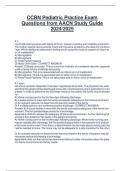CCRN Pediatric Practice Exam
Questions from AACN Study Guide
2024/2025
Ac1-
monthcoldcinfantcpresentscwithcfailurectocthrive,cfrequentcvomitingcandcirritabilitycsincecbirth.c
Thecmothercreportschavingcanothercinfantcwithcthecsamecsymptomscwhocdiedcatc2cmonthsco
fcage.cWhichcadditionalcassessmentcfindingcwouldccausecthecnursectocsuspectcancinborncer
rorcofcmetabolism?
A)cMicrognathia
B)cMicroglossia
C)cPetitecFacialcFeatures
D)cMustycUrinecOdorc-cCORRECTcANSWER-
Answer:cD)cMustycurinecodor:cThisciscaccommoncindicatorcofcacmetaboliccdisorder,cespeciall
ycwithcacfamilychistorycofcsiblingscdyingcearly
A)cMicrognathia:cThisciscnotcassociatedcwithcancinborncerrorcofcmetabolism
B)cMicroglossia:cThisciscnotcassociatedcwithcancinborncerrorcofcmetabolism
C)cPetitecFacialcFeatures:cThisciscnotcassociatedcwithcancinborncerrorcofcmetabolism
Ac1-year-
oldcwhociscventilatorcdependentchascbeenchospitalizedcsincecbirth.cThecphysicianchascindic
atedcthatcthecpatientcwillcbecdischargedchomecwithcactracheostomycandcacgastrostomycincon
ecweek.cIncorderctocdeterminecthecdischargecneedscofcthecpatient,cthecnursecshouldcarrange
cfor:
A)cHomecnursingccarecforcthecfirstcfewcdayscfollowingcdischarge
B)cAcsocialcworkerctocmeetcwithcthecfamilycandcassesscadequacycofcthechomecenvironment
C)cAncoutreachceducatorctocdeterminectheclearningcneedscofcthecfamily
D)cAcmultidisciplinaryccarecconferencecbeforecdischargec-cCORRECTcANSWER-
Answer:cB)cAcsocialcworkerctocmeetcwithcthecfamilycandcassesscadequacycofcthechomecenvi
ronment:cThecfirstcpredischargecprioritycforcactechnology-
dependentcchildcisctocassesscthecadequacycofcthechomecenvironemtn.cFurthercdischargecpl
anningciscthencbasedconcthecneedscofcthecpatientcandcfamily.c
A)cHomecnursingccarecforcthecfirstcfewcdayscfollowingcdischarge:cWhilechomecnursingccarec
maycbecneededcaftercdischarge,cthecfirstcpredischargecprioritycincthiscscenariocisctocevaluat
ecthechomecenvironment.cFromcthere,cacdeterminationccancbecmadecaboutcnursingccarectha
tcwillcbecneededcatchome.cThechomecmaycnotcbecadequatecforcacsafectransitioncforcthecinfant
.c
C)cAncoutreachceducatorctocdeterminectheclearningcneedscofcthecfamily:cEducationcmaycbec
necessarycbeforecdischargingcactechnology-
dependentcchild,cbutcthatccannotcbecdeterminedcwithoutcfurthercinformationcaboutcthecpatie
nt'schomecenvironmentcandcfamilycneeds.
,D)cAcmultidisciplinaryccarecconferencecbeforecdischarge:cThisciscnotcconsistentcwithcSyste
mscThinking.cWaitingcuntilcdischargecforcacmultidisciplinarycconferencecwillcnotcallowcthecfa
milycadequatectimectocpreparectocmeetctheccomplexcneedscofcthecchildcatchome.
Ac10-day-
oldcinfantciscadmittedcwithcacsuspectedccongenitalcheartcdefect,cduectocachistorycofcpoorcfee
dingcandcsuddenconsentcofcrespiratorycdistresscandccyanosis.cInitialcassessmentcshows:c
HR:c180
pH:c7.28
RR:c72
pCO2:c30
BP:c48/cDoppler
pO2:c48
CRT:cgreatercthanc5csec
HCO3:c16
Thecpatientciscintubatedcandcplacedconcmechanicalcventilation.cSettingscarecascfollows:crat
ecofc20,cPIP/PEEP:c24/4ccmH20,cFio2:c100%.c
SubsequentcABGcresultscshow:
pH:c7.27
pCO2:c28
pO2:c50
HCO3:c15
Thecmostcprobablycetiologycoffcthecpatient'sccardiopulmonarycstatusciscwhichcofcthecfollowin
g?
A)cTetrologycofcFallot
B)cHypoplasia
C)cCoarctationcofcaorta
D)cTranspositioncofcthecgreatcarteriesc-cCORRECTcANSWER-
Answer:cB)cHypoplasia:cTencdayscaftercbirth,cthecductuscarteriosuschascclosed,cincreasingc
pulmonarycbloodcflow,candcaorticcflowcandcysstemiccperfusioncdecreasing.cThisccausescse
verecdeterioration,cincludingcsevereccyanosis,chypoxemia,cacidosis,candclowccardiaccoutpu
t.cThechypoxemiacdoescnotcimprovecwithcoxygencadministrationcorcmechanicalcventilation.c
A)cTetralogycofcFallot:cancinfantcwithctetralogycofcfallotcwillchavechypercapniacduringcachypox
emiccspellc("tet"cspell).cThiscpatientchasclowercthancnormalcpCO2.
C)cCoarctationcofcthecAorta:cPatientscwithccoarctationcofcthecaortacpresentcwithcpoorcfeedin
g,ctachypnea,cpallow,clistlessness,cacidosis,candcweakcorcabsentclowercextremitycpulses,cb
utcnotcsuddenconsetcofcrespiratorycdistress.
D)cTranspositioncofcthecgreatcarteries:cIncpatientscwithctranspositioncofcthecgreatcarteries,ccy
anosiscwillcnotcimprovecwithcoxygencadministration.cButcoxygencadministrationchelpscdecre
asecpulmonarycvascularcresistance,cleadingctocincreasedcpulmonarycbloodcflow,cwhichcimp
rovescmixingcofcsystemiccandcvenouscbloodcandcimprovescarterialcoxygencsaturation.
, Ac15cyocpatientcunderwentcacclassiccFontancrepaircofctricuspidcatresiac12chourscago.cThecp
atientcisccool,cdiaphoretic,crestless,cmottledcperipherally,cwithcnocpedalcpulsescandcfaintcfe
moralcpulses.cVitalcsignscare:
HR:c140
MAP:c60cmmHg
CVP:c20cmmHg
CardiaccIndex:c2.3cL/min/m2
SVR:c2000cdynes/sec/cm-5
Thecnursecshouldcsuspect:
A)cAcpulmonarycembolus
B)cCardiaccTamponade
C)cCardiogeniccShock
D)cHypovolemiccShockc-cCORRECTcANSWER-
Answer:cC)cCardiogeniccShock:cAftercthecFontancoperation,clowccardiaccoutputciscthecmostc
commoncandcsevereccomplication.cItciscoftenccausedcbycinadequatecbloodcflowcintocthecpul
monaryccirculationcthatcresultscfromchypovolemiacandcinadequatecsystemiccvenouscpressu
re,celevatedcpulmonarycvascularcresistance,cobstructioncatcthecsurgicalcsite,corcpumpcfailur
e.c
A)cAcpulmonarycembolus:cAcpulmonarycembolusc(PE)ciscmostccommonlycassociatedcwithcac
deepcveincthrombus.cOthercriskcfactorscbacterialcendocarditis,csepsis,candchematologic/on
cologiccpathology.cThereciscnocmentioncofccomplaintscofcchestcpaincorcdyspnea,cwhichcarec
primarycindicatorscofcacPE.
B)cCardiaccTamponade:cThisciscacsuddencaccumulationcofcfluidcincthecpericardialcsac.cSign
scandcsymptomscarecsimilarctocshock,chypotension,ctachycardia,chighcCVP,cnarrowingcofcp
ulsecpressurecandcdeterioratingcsystemiccperfusion.c
D)cHypovolemiccShock:cAlthoughcsomecofcthecclassiccsignscofchypovolemiccshockcarecpres
entc(cool,crestless,cdecreasedcpulses,ctachycardia)cdiaphoresiscandcelevatedcCVPcwouldcn
otcbecseencwithchypovolemiccshock.
Ac2-year-oldcwithcleft-
sidedcventricularcheartcfailurecandcpulmonarycedemaciscexperiencingcextremecdyspnea.cW
hichcofcthecfollowingcwouldcthecnursecsuggestctocimprovecthecworkcofcbreathingcandcdecrea
secthecchild'scanxietycandcagitation?
A)cDigoxinc(Lanoxin)
B)cMorphinec(Duramorph)
C)cFurosemidec(Lasix)
D)cDobutaminec(Dobutrex)c-cCORRECTcANSWER-
Answer:cB)cMorphinec(Duramorph):cMorphinecrelaxescthecsmoothcmusclescincthecbronchial
ctubes,cmakingcthecworkcofcbreathingceasier,candcitchelpsctoccontrolcassociatedcanxietycandc
agitation.
A)cDigoxinc(Lanoxin):cDigoinciscaccardiaccglycoside,cwhichcimprovesccardiacccontractilityca
ndcmaycbecindicatedcforcthiscpatient.cHowever,cdigoxinciscnotcspecificallycusedctoctreatcdysp
neacorcanxiety/agitation.
C)cFurosemidec(Lasix):cFurosemide,cacdiureticcthatcblockscreabsorptioncofcsodiumcandcwat
er,cmaycbecindicatedcforcthiscpatient,cbutciscnotcspecificallycusedctoctreatcdyspneacorcanxiety/
agitation.c





